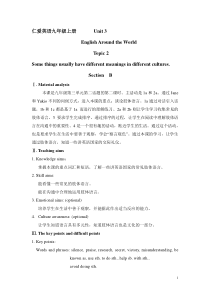 DOC
DOC
【文档说明】《Review of Unit 5》教案设计2-九年级下册英语仁爱(科普版).doc,共(3)页,46.000 KB,由小喜鸽上传
转载请保留链接:https://www.ichengzhen.cn/view-105186.html
以下为本文档部分文字说明:
1仁爱英语九年级上册Unit3EnglishAroundtheWorldTopic2Somethingsusuallyhavedifferentmeaningsindifferentcultures.SectionBⅠ.Mater
ialanalysis本课是九年级第三单元第二话题的第二课时。主活动是1a和2a。通过Jane和Yukio不同的问候方式,进入本课的重点:谈论肢体语言。1a通过对话引入话题,1b和1c都是基于1a而进行的理解练习。2a和2b则
让学生学习收集常见的肢体语言。3要求学生完成排序,通过排序的过程,让学生在阅读中理解肢体语言在沟通中的重要性。4是一个很有趣的活动,贴近学生的生活。通过这个活动,也是要求学生在生活中要善于观察,学会“察言观色”。通过本课的学习,让学生通过肢体语言,知道一些讲英语国家的交际礼仪。Ⅱ.Teaching
aims1.Knowledgeaims:掌握本课的重点词汇和短语,了解一些讲英语国家的常见肢体语言。2.Skillaims:能看懂一些常见的肢体语言。能在沟通中合理地运用肢体语言。3.Emotionalaims:(optiona
l)培养学生在生活中善于观察,并能据此作出适当反应的能力。4.Cultureawareness:(optional)让学生知道语言具有多元性,知道肢体语言也是文化的一部分。Ⅲ.Thekeypointsanddifficultpoin
ts1.Keypoints:Wordsandphrases:silence,praise,research,secret,victory,misunderstanding,beknownas,usesth.tod
osth.,helpsb.withsth.,avoiddoingsth.2Sentences:Iwonderifbodylanguagemeansthesamethinginallcultures.Ithinkthatisknownas
bodylanguage.Grammar:Expressingthefuturebypresentcontinuous.2.Difficultpoints:能理解在不同的国家,同一个肢体语言的含义是有差异的。
Ⅳ.Learningstrategies在交际的过程中,遇到语言障碍,能运用肢体语言来辅助交际。在学习的过程中,要有意识地收集一些讲英语国家的常见肢体语言。在做1c时,要学会使用速记的方法。Ⅴ.Teachingprocedures1.Revisionandleadnewlesson.
Showapicture.T:Doyourememberthegesture?Ss:Yes.T:Michaelseesastrangerputtingouthishandwithhisthumbraised.Whatdoesitmean?Ss:As
kforaride.T:Yes,youareright.Doyouknowanyothermeaningsofthisgesture?Ss:…T:Thegestureisakindofbodylanguage.Doyouknowanyothe
rbodylanguages?Actthemout.2.Pre-listeningShowsomepicturesaboutbodylanguage.Bereadyforlistening.3.While-l
isteningStep1:T:NowKangkangJaneandYukioaretalkingaboutbodylanguage.Listenandchoosethecorrectanswer.()(1)HowdoesJanesay“hi
”?A.Shewavesherhand.B.Shesmiles.C.Shebows.()(2)HowdoesMissWangshowherunhappiness?3A.Sheraiseshervoice.B.Shecrossesherarmsa
ndstampsherfoot.C.Sheputsherhandsonherhips.Step2:1bListento1aagainandmarkT(true)orF(False).4.Post-listeningStep1:Li
stento1aandfollow.Practice1aingroups.Act1aoutingroups.Finish1calone.Checktheanwers.Read1aagain,discussingroups,andshow
thekeypoints.Step2(1)LettheSsstudyanddiscussthegesturesin2aandtrytomatchthemeaningwiththegesture.(2)Checktheanswersandteachthenewwords“secret,
puzzled,victory”.Finish2a.(3)LettheSsdiscussingroups.Collectmoregestures.Encouragesomegroupstoactout,andletthe
otherSsguesswhattheymean.Finish2b.5.FinishingTask3LettheSsread3carefullyandputitinthecorrectorder.FirstlettheSsdoitalone,andthencheckingroups.
RemindtheSstopayattentiontothetopicsentence,thesupportingsentenceandtheconjunctionwords:but,so,however.6.FinishingTask4LettheSsreadthein
structionsin4anddiscussoneoftheirteachers’/classmates’typicalbodylanguage.Encouragethemtoreporttothewholeclass.F
inish4.7.SummarizingandassigninghomeworkStep1:LettheSssumupwhattheyhavelearnedinSectionB.Step2:HMK:(1)Recitewordsphrasesandusefu
lexpressions.(2)LettheSssearchsomeChineseidiomsaboutdogs,dragonsandmice.Findoutthespecialmeaningsofpeacock,bat,andbamboo.(3)PreviewSectionC.
 辽公网安备 21102102000191号
辽公网安备 21102102000191号
 营业执照
营业执照